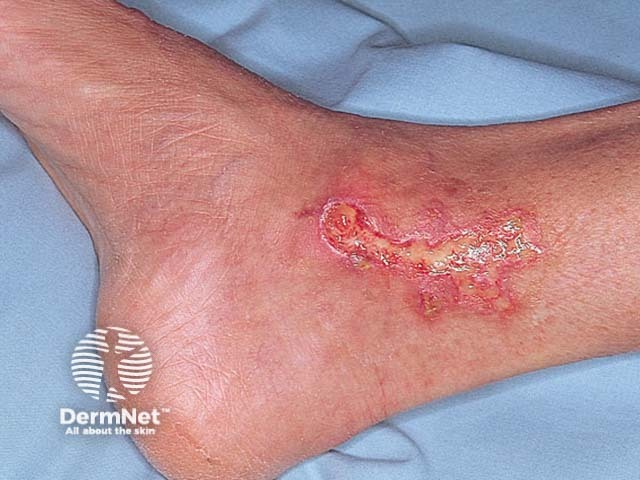Main menu
Common skin conditions

NEWS
Join DermNet PRO
Read more
Quick links
Mixed diagnoses – 10 cases (6 of 11)
For each of the ten cases, study the image(s) and then answer the questions. You can click on the image to view a larger version if required.
Each case should take approximately five minutes to complete. There is a list of suggested further reading material at the end of the quiz.
When you finish the quiz, you can download a certificate.
Case 7

What is this condition?
This is pyoderma gangrenosum, an uncommon ulcerating skin disease characterised by pathergy (it develops at sites of trauma or even injections). A papule or pustule rapidly enlarges to an ulcer with a purple-coloured overhanging margin and an irregular shape. Histology shows a neutrophilic infiltration without a vasculitis. Culture is sterile.
What underlying systemic diseases should be considered?
Pyoderma gangrenosum is associated with an underlying systemic disease in at least 50% of cases. The most common are inflammatory bowel disease, myeloid dysplasias, rheumatoid arthritis or chronic active hepatitis.
How would you treat it?
Pyoderma gangrenosum frequently responds poorly to medical treatment. Surgery should be avoided where possible, especially in the active phase of the disease (which may last several months) because it may significantly aggravate the ulceration. Measures which can help include: active treatment of the underlying systemic disease, if any; gentle debridement of devitalized tissue; occlusive dressings (providing there is no secondary infection); systemic steroids (often a high dose of oral prednisone or pulse intravenous dexamethasone is required); dapsone. Mild cases may respond to anti-inflammatory antibiotics such as minocycline or cotrimoxazole. Resistant cases may respond to ciclosporin or cyclophosphamide. Management by a specialist dermatologist is advisable.
